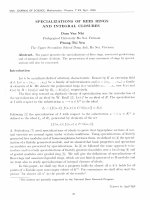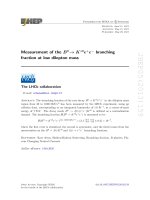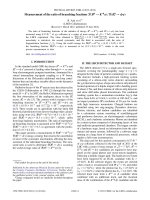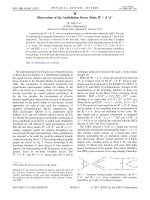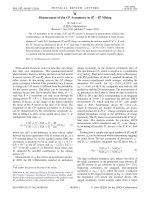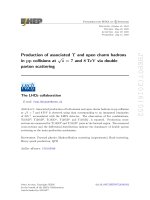DSpace at VNU: Comparison of Alcoholic Fermentation Performance of the Free and Immobilized Yeast on Water Hyacinth Stem Pieces in Medium with Different Glucose Contents
Bạn đang xem bản rút gọn của tài liệu. Xem và tải ngay bản đầy đủ của tài liệu tại đây (218.35 KB, 10 trang )
Appl Biochem Biotechnol (2014) 172:963–972
DOI 10.1007/s12010-013-0574-7
Comparison of Alcoholic Fermentation Performance
of the Free and Immobilized Yeast on Water Hyacinth
Stem Pieces in Medium with Different Glucose Contents
Van Nguyen Tran & Van Viet Man Le
Received: 5 August 2013 / Accepted: 30 September 2013 /
Published online: 15 October 2013
# Springer Science+Business Media New York 2013
Abstract Ethanol fermentation with Saccharomyces cerevisiae cells was performed in
medium with different glucose concentrations. As the glucose content augmented from
200 to 250 g/L, the growth of the immobilized cells did not change while that of the free
cells was reduced. At higher glucose concentration (300, 350, and 400 g/L), the cell
proliferation significantly decreased and the residual sugar level sharply augmented for both
the immobilized and free yeast. The specific growth rate of the immobilized cells was 27–
65 % higher than that of the free cells, and the final ethanol concentration in the immobilized
yeast cultures was 9.7–18.5 % higher than that in the free yeast cultures. However, the
immobilized yeast demonstrated similar or slightly lower ethanol yield in comparison with
the free yeast. High fermentation rate of the immobilized yeast was associated with low
unsaturation degree of fatty acids in cellular membrane. Adsorption of S. cerevisiae cells on
water hyacinth stem pieces in the nutritional medium decreased the unsaturation degree of
membrane lipid and the immobilized yeast always exhibited lower unsaturation degree of
membrane lipid than the free yeast in ethanol fermentation.
Keywords Fatty acid . High density medium . Immobilized yeast . Saccharomyces cerevisiae .
Water hyacinth
Introduction
Ethanol has re-emerged as an alternative to petroleum-based liquid fuels due to energy crisis
[1]. Many studies have been performed in order to improve economic efficiency of ethanol
production [2, 3]. It has been reported that using media with high sugar concentration
resulted in high ethanol level in the fermentation broth and that could lead to great savings
in process water and energy requirements in ethanol industry [2]. However, high sugar
content in media inhibited yeast growth and lengthened the fermentation as a result of high
V. N. Tran : V. V. M. Le (*)
Department of Food Technology, Ho Chi Minh City University of Technology,
Ho Chi Minh City, Vietnam
e-mail:
964
Appl Biochem Biotechnol (2014) 172:963–972
osmotic pressure. In addition, increase in osmotic pressure of media could lead to an
incomplete fermentation [2, 4].
Application of immobilized yeast could lower the inhibitory effects in media with high sugar
content [5, 6]. The yeast cells entrapped in different gel matrices [5] or adsorbed on sintered
glass beads [6] fermented sugar faster than the free yeast in high-density media. Nevertheless,
the osmotolerance of the immobilized yeast varied from matrix to matrix. From the last decade,
using natural supports with high-cellulose content for yeast immobilization has attracted great
attention [3]. These supports are low in cost, environmentally friendly, and abundantly available
in many world regions [7]. Yeast cells adsorbed on different cellulosic supports were used in
ethanol fermentation and the sugar concentration in the medium varied from 50 to 200 g/L
[8–10]. There have been so few studies on alcoholic fermentation performance of the
immobilized yeast on cellulosic supports in high-density media.
In this study, water hyacinth stem pieces were used as new cellulosic support for yeast
immobilization and the immobilized biocatalyst was then inoculated in the medium with
different glucose concentrations for ethanol fermentation. Water hyacinth (Eichhornia
crassipers) is a fast-growing aquatic plant widely distributed throughout the world. This plant
has been used in the production of paper, crafts, rope, and furniture. Water hyacinth stem has
been known as a good adsorbent material with a large specific surface [11]. According to Yu
et al. [12], cellulosic material with high porous structure could be used as support for yeast
immobilization. There has been no study on yeast immobilization on water hyacinth stem pieces.
In high-density media, yeast cells suffered different stresses including osmotic and
ethanol inhibition [13]. The survival and metabolism of yeast cells depended on their ability
to adapt quickly to the changing environment. Change in plasma membrane composition
could be an adaptive response by the yeast since it was highly variable and clearly
influenced by environmental factors [14]. There have been many studies to investigate fatty
acid levels in cellular membrane as the yeast was exposed to high ethanol concentration [4,
15–17]. Nevertheless, the effect of high sugar concentration on fatty acid composition in
cellular membrane of the immobilized yeast was only reported in a unique study of HilgeRotmann and Rehm [6] who used alginate gel and sintered glass beads as supports for
immobilization of yeast cells.
The objective of this research was to compare the alcoholic fermentation performance of
the free and immobilized yeast on water hyacinth stem pieces in the medium with different
glucose contents. In addition, fatty acid composition in cellular membrane of the
immobilized and free yeast during the fermentation was also evaluated. The obtained results
would give a clearer understanding about the improvement in fermentation rate of the
immobilized yeast in medium with high sugar content.
Materials and Methods
Yeast
Saccharomyces cerevisiae TG1 from the culture collection of Food Technology Department,
Ho Chi Minh City University of Technology was used.
Support
Water hyacinth (E. crassipers) stems were washed with potable water to remove adhering
dirt, cut into cylindrical pieces, and subsequently sterilized at 121 °C for 20 min. After
Appl Biochem Biotechnol (2014) 172:963–972
965
cooling, the support was ready for cell immobilization. The height and diameter of the
support were approximately 1 and 2 cm, respectively.
Media
Medium A was used for yeast growth and immobilization. The medium contained glucose
(120 g/L), yeast extract (4 g/L), (NH4)2SO4 (1 g/L), KH2PO4 (1 g/L), and MgSO4 (5 g/L).
Medium B was used for ethanol fermentation. The chemical composition of medium B was
similar to that of medium A except that the glucose concentration was adjusted to 200–400 g/L.
Yeast Immobilization
Yeast cells were grown at 30 °C for 24 h in medium A and subsequently separated at 4 °C in
a refrigerated centrifuge (Sartorius, Switzerland). For yeast immobilization, the cells were
resuspended in medium A to form a yeast suspension with the cell concentration of 3.5×
107 cfu/mL; 30 g support was then added into 500-mL shake flask containing 140 mL yeast
suspension and the mixture was incubated in a thermostat shaker (Sartorius, Switzerland) at
30 °C for 20 h. Finally, the support with immobilized cells was removed and washed with
sterile water three times. The cell density was 4.5×108 cfu/g wet support. The immobilized
yeast obtained was ready for ethanol fermentation.
Fermentation
Static fermentation was conducted at 30 °C in 1 L Erlenmeyer flasks containing 500 mL of
medium B. The inoculum size was 1.0×107 cfu/mL. Control samples with free yeast cells
were simultaneously carried out under the same conditions. The fermentation was considered completed when the residual sugar concentration was unchanged during 12 consecutive
hours.
Analytical Methods
Cell Density in Yeast Cultures and Specific Growth Rate
The cell density in the free yeast culture (colony forming unit per milliliter) was determined
by plate count agar with glucose–peptone agar medium and the incubation was performed at
30 °C for 48 h [18].
The immobilized cells on the support were quantified by the procedure as described
previously [18] with slight modification. Five grams of the support and 95 mL distilled water
were ground in a grinder at 3,000 rpm for 5 min; the cell number in the suspension obtained
was determined by plate count agar with glucose–peptone agar medium and the incubation
was performed at 30 °C for 48 h. The cell density in the immobilized yeast culture was
calculated and expressed as colony forming unit per milliliter fermented medium.
The specific growth rate of the free and immobilized yeast was calculated according to
the formula described elsewhere [19].
Glucose
Glucose content was evaluated by spectrophotometric method using 3,5-dinitrosalicylic acid
reagent [20].
966
Appl Biochem Biotechnol (2014) 172:963–972
Ethanol
Ethanol concentration was determined by enzymatic method using ethanol kit with a
reflectometer model 116970 (MercK KgaA, Germany). Under the catalytic effect of alcohol
dehydrogenase, alcohol is oxidized by NAD to acetaldehyde. In the presence of an electron
transmitter, the NADH formed in the process reduces a tetrazolium salt to a blue formazan
that is determined reflectometrically.
Fatty Acid Composition of Yeast Cell Membrane
Prior to determine fatty acid composition, the lipid in yeast cell membrane was extracted
using method proposed previously [21] with slight modification. Yeast biomass was added
into methanol and the mixture was subsequently treated with ultrasound by an ultrasonic
probe model VC 750 (Sonics & Materials Inc., USA) at an ultrasonic power of 5 W/g for
1 min to disrupt the cell wall. The lipid extraction was then carried out by adding chloroform
and methanol (2:1 v/v) to the sonicated mixture. The weight ratio of material and solvent was
5:2. The extraction was performed at the agitation rate of 200 rpm for 2 h. The organic phase
was then transferred into a glass screw tube containing 0.88 % KCl solution. The mixture
was centrifuged at 25 °C and 3,000 rpm for 5 min. The organic phase was then collected and
used for determination of fatty acid composition.
Fatty acid composition was determined by gas chromatography using a Hewlett-Packard
model 5890A (Hewlett-Packard, USA). The extract was injected into an FFAP-HP column
of 25 m×0.2 mm with an HP automatic injector. Helium was used as carrier gas at
1.0 mL/min and heptadecanoic acid methyl ester (1 μg/μL) was added as an internal
standard. Column inlet pressure was 150 kPa. The injector temperature was 250 °C.
Detector temperature was 250 °C. The temperature program was 25 °C/min from 70 to
200 °C. Peak areas were measured using a Hewlett-Packard model 3396A integrator.
Unsaturation Degree of Fatty Acids in Yeast Cell Membrane
Unsaturation degree of fatty acids in yeast cell membrane was calculated from the fatty acid
composition in cellular membrane using the following formula [22].
Δ=mol ¼ ½1ðmol % monoenesÞ þ 2ðmol % dienesÞ þ 3ðmol % trienesÞ=100
Statistical Treatment
The presented results were the average of three independent experiments. The obtained
results were subjected to analysis of variance (p<0.05) using Statgraphics plus software,
version 3.2.
Results and Discussion
Yeast Growth
Yeast growth was evaluated by specific growth rate and maximum cell density in the
cultures. Table 1 shows that increase in initial glucose concentration from 200 to 400 g/L
Appl Biochem Biotechnol (2014) 172:963–972
967
Table 1 Effects of initial glucose contents on the specific growth rate and maximum cell density in the
immobilized and free yeast cultures
Initial glucose content (g/L)
Specific growth rate (h−1)
Maximum cell density (107 cfu/mL)
Immobilized cells
Immobilized cells
Free cells
Free cells
200
0.61±0.015a
0.48±0.011b
8.5±0.04j
4.9±0.05m
250
0.61±0.018a
0.37±0.017d
8.5±0.04j
4.7±0.06n
300
350
0.47±0.006b
0.43±0.013c
0.33±0.015e
0.29±0.016f
7.7±0.03k
6.9±0.06l
4.3±0.07o
3.8±0.07p
400
0.41±0.023c
0.26±0.005i
6.8±0.05l
3.1±0.01q
Various letters in the table indicate significant differences (p<0.05)
gradually reduced the specific growth rate and maximum cell density in the fermented
medium with the free yeast. For the immobilized yeast, the growth did not change when
the glucose content augmented from 200 to 250 g/L. However, further increase in glucose
content resulted in a reduced growth of the immobilized cells. Recently, Lainioti et al. [23]
reported that the growth of the immobilized yeast in wheat and corn starch gels was
considerably reduced due to high osmotic stress and high level of ethanol in the fermented
medium as the initial glucose concentration increased from 205 to 300 g/L.
In all investigated cases, the specific growth rate of the immobilized yeast on water
hyacinth stem pieces was 27–65 % higher than that of the free yeast. In addition, the
maximum cell density in the immobilized yeast culture was 73–119 % higher than that in
the free yeast culture. Similar observation was reported by Ton et al. [24] who used the
immobilized yeast on bacterial cellulose support in wine fermentation. According to
Puligundla et al. [2], immobilization protected the microbial cells against the possible toxic
effects of substrates or products. As a result, the growth of the immobilized cells was
inhibited less than that of the free cells in high density medium.
Sugar Assimilation
For the free yeast, Table 2 shows that the higher the initial glucose content in the medium
was, the higher the residual glucose content in the fermentation broth was. Similar results
Table 2 Effects of initial glucose concentrations on the residual sugar level and fermentation time of the
immobilized and free yeast
Initial glucose concentration (g/L)
Residual sugar content (g/L)
Fermentation time (h)
Immobilized yeast
Immobilized yeast
Free yeast
Free yeast
200
6.9±0.8a
8.5±0.3a
42.0±0.6i
52.0±0.6j
250
9.7±0.8a
47.7±0.6c
55.0±0.7k
62.0±0.7l
300
41.4±1.6b
89.9±0.8e
60.0±1.9l
67.1±0.8m
350
79.9±1.4d
141.5±2.6f
64.0±0.9n
66.7±1.1m
400
149.0±1.1g
191.2±1.5h
64.1±1.8n
67.3±0.4m
Various letters in table indicate significant differences (p<0.05)
968
Appl Biochem Biotechnol (2014) 172:963–972
were reported for the free yeast cells as the level of soluble solids in sweet sorghum juice
medium increased from 24 to 32 °Bx [1]. According to D'Amore et al. [4], high osmotic
pressure inhibited the diffusion of produced ethanol to the external medium and increased
accumulation of intracellular ethanol was toxic to the yeast. Consequently, glucose conversion to ethanol by yeast could not be completed.
As the glucose concentration in the medium was 200 g/L, analysis of variance showed
that the content of sugar assimilated by the immobilized and free yeast was similar.
However, when the initial sugar content increased from 200 to 250 g/L, the residual glucose
concentration in the free yeast culture augmented sharply while that in the immobilized yeast
culture remained constant. The experimental results affirmed that glucose adsorption on
water hyacinth stem pieces was not observed at the end of the fermentation (data not shown).
As a result, the immobilized yeast on water hyacinth stem pieces was more tolerant to
osmotic stress than the free yeast. When the initial glucose content varied from 250 to
400 g/L, the concentration of residual sugar in the immobilized yeast culture was 1.3–4.9
times lower than that in the free yeast culture. The immobilized yeast therefore assimilated
more sugar than the free yeast in high density medium.
At the glucose level of 200 g/L, the fermentation time of the immobilized cells on water
hyacinth stem pieces was 19 % shorter than that of the free cells. Formally, the use of the
immobilized yeast on delignified cellulosic support reduced the ethanol fermentation time of
15 % in comparison with the free yeast when molasses medium with 198 g/L of sucrose was
used [25]. The results in Table 2 confirmed that the fermentation time of the immobilized
yeast on water hyacinth stem pieces was significantly shorter than that of the free yeast at all
investigated sugar concentrations. Consequently, the fermentation rate expressed by glucose
uptake rate of the immobilized cells on water hyacinth stem pieces was always higher than
that of the free cells. Similar observation was reported by Holcberg and Margalith [5] when
the immobilized yeast in agar gel was inoculated in high-density medium.
Ethanol Formation
When the initial sugar content increased 50 % (from 200 to 300 g/L), the final ethanol
content just increased 28 % (from 88.31 to 112.63 g/L) and 18 % (from 80.51 to 95.03 g/L)
for the immobilized and free yeast, respectively (Table 3). In addition, the ethanol content in
the fermentation broth was reduced as the glucose concentration in the medium augmented
from 300 to 350 or 400 g/L. This observation confirmed that ethanol formation of both
immobilized and free yeast was inhibited in high density medium. Formerly, Laopaiboon
Table 3 Effects of initial glucose concentrations on the ethanol formation of the immobilized and free yeast
Initial glucose content (g/L) Ethanol concentration (g/L)
Immobilized yeast Free yeast
Ethanol yield (mol ethanol produced/mol
glucose assimilated)
Immobilized yeast
Free yeast
200
88.31±0.63d
80.51±0.47e
1.71±0.03k
1.71±0.02k
250
98.26±1.26b
88.71±0.47d
1.70±0.03k
1.76±0.04k
300
112.63±0.47a
95.03±1.03c
1.61±0.03j
1.78±0.05k
350
98.90±1.34b
89.11±1.03d
1.43±0.02i
1.67±0.01m
400
89.50±0.95d
80.74±1.82e
1.33±0.05h
1.35±0.01h
Various letters in the table indicate significant differences (p<0.05)
Appl Biochem Biotechnol (2014) 172:963–972
969
et al. [1] demonstrated that increase in soluble solid level in the medium from 24 to 28 °Bx
just augmented the ethanol concentration from 113.2 to 117.3 g/L as the free cells of S.
cerevisiae were used in high gravity fermentation.
In all investigated cases, the final ethanol concentration in the immobilized yeast culture
was 9.7 to 18.5 % higher than that in the free yeast culture. Nevertheless, the immobilized
yeast demonstrated similar or slightly lower ethanol yield in comparison with the free yeast.
It was probably due to high cell growth of the immobilized yeast. Low ethanol yield was a
drawback in ethanol fermentation for the immobilized cells on water hyacinth stem pieces.
Similar results were reported when the immobilized yeast in gel matrices was used in ethanol
fermentation [26]. It can be noted that increase in initial glucose content from 300 to 400 g/L
decreased the ethanol yield of both the immobilized and free cells.
Although the ethanol yield of the immobilized cells on water hyacinth stem pieces was
similar to or slightly lower than that of the free cells, the immobilized yeast on this support
grew better and produced more ethanol than the free yeast; the fermentation rate of the
immobilized yeast was higher than that of the free yeast. Fatty acid composition in cellular
membrane of the immobilized and free yeast was analyzed and compared in order to clarify
yeast response in the medium with different sugar concentrations. In ethanol industry, the
content of soluble solids in the medium varied from 14 to 22 °Bx [27]. In this experiment,
the media with glucose content of 200 and 300 g/L were selected as conventional medium
and high density medium, respectively, for ethanol fermentation.
24
20
Oleic acid (%)
Palmitoleic acid (%)
22
18
16
14
12
10
22
20
18
16
14
8
6
12
0
12
24
36
48
60
0
12
Time (h)
36
48
60
48
60
Time (h)
40
22
38
Stearic acid (%)
Palmitic acid acid (%)
24
36
34
32
20
18
16
14
12
30
0
12
24
36
Time (h)
48
60
10
0
12
24
36
Time (h)
Fig. 1 Change in fatty acid levels in cellular membrane of the free and immobilized yeast Sacchoromyces
cerevisiae during ethanol fermentation. Dashed lines immobilized yeast, solid lines free yeast,
,
medium with 200 g/L glucose,
medium with 300 g/L glucose
970
Appl Biochem Biotechnol (2014) 172:963–972
Our preliminary studies showed that for S. cerevisiae TG1, the level of palmitic (C16:0),
stearic (C18:0), palmoleic (C16:1), and oleic (C18:1) acid was dominant in comparison with
that of other fatty acids in cellular membrane of the immobilized and free yeast. According
to Fig. 1, the relative percentage of saturated fatty acids (C16:0 and C18:0) gradually
augmented while that of unsaturated fatty acids (C16:1 and C18:1) decreased during the
fermentation for both the immobilized and free cells. These changes were observed in both
conventional medium (200 g/L glucose) and high density medium (300 g/L glucose) for
ethanol fermentation.
For the immobilized yeast, our results agreed with the study of Hilge-Rotmann and Rehm
who used 10 % glucose medium and yeast entrapped in alginate gel or yeast adsorbed on
sintered glass beads for ethanol fermentation under anaerobic condition [6].
For the free yeast, our results contrasted with the findings of some previous studies. For S.
cerevisiae IMM 30, Hilge-Rotmann and Rehm [6] demonstrated a nearly constant composition of palmitoleic, oleic, and stearic acid in the free cells while the level of palmitic acid
(16:0) slightly increased as 10 % glucose medium was used in alcoholic fermentation.
Meanwhile for S. cerevisiae LH 02/2, the relative percentage of palmitic and stearic acid
in cellular membrane of the free cells decreased whereas that of palmitoleic and oleic acid
increased during the fermentation when the glucose medium supplemented with 5–15 %
ethanol was used [16]. However, our results were similar to the study in which the free cells
of S. cerevisiae NCYC 431 were used for ethanol fermentation [15]. It was assumed that
different changes in fatty acid levels in yeast cell membrane during ethanol fermentation
probably depended on yeast strain and physiological state of yeast cells.
There has been no study to compare the unsaturation degree of fatty acids in cellular
membrane of S. cerevisiae at the start and at the end of the cell immobilization process.
Figure 2 shows that the adsorption of S. cerevisiae TG1 cells of on water hyacinth stem
pieces in medium A reduced the unsaturation degree of fatty acids in cellular membrane. It
was suggested that this phenomenon would modify physiological state of the immobilized
Unsaturation degree (1/mol)
0.55
0.5
0.45
0.4
0.35
0.3
A
B
C
D
E
F
Fig. 2 The unsaturation degree of fatty acids in cellular membrane. a Yeast at the start of the immobilization
process. b Yeast at the end of the immobilization process. c Free yeast at the end of the fermentation (medium
with 200 g/L glucose). d Immobilized yeast at the end of the fermentation (medium with 200 g/L glucose). e
Free yeast at the end of the fermentation (medium with 300 g/L glucose). f Immobilized yeast at the end of the
fermentation (medium with 300 g/L glucose)
Appl Biochem Biotechnol (2014) 172:963–972
971
biocatalyst in comparison with that of the free yeast. The unsaturation degree of membrane
lipid of both the immobilized and free yeast was significantly reduced at the end of the
fermentation. However, the unsaturation degree of the immobilized yeast was always lower
than that of the free yeast not only in the conventional medium (200 g/L glucose) but also in
high-density medium (300 g/L glucose) for ethanol fermentation. It can be affirmed that low
degree of unsaturation of the immobilized yeast on water hyacinth stem pieces was associated with high fermentation rate and high level of ethanol produced.
This result was different to the findings of some authors who reported that increase in
unsaturated fatty acid level in cellular membrane resulted in increased fermentation rate of
the free yeast [22]. Nevertheless, our result was agreed with Hilge-Rotmann and Rehm [6]
who reported that the unsaturation degree of membrane lipid of the yeast entrapped in
alginate gel and adsorbed on sintered glass was lower than that of the free yeast when the
glucose content in the medium increased from 200 to 250 and 300 g/L. These authors stated
that low unsaturation degree of fatty acids in cellular membrane favored faster removal of
ethanol molecules from the cells; moreover, low degree of unsaturation was associated with
improved fermentation rates of yeast cells.
Conclusion
Increase in initial glucose concentration from 200 to 400 g/L decreased the growth of the
free yeast. For the immobilized yeast on water hyacinth stem pieces, the growth was only
reduced when the glucose content augmented from 250 to 400 g/L. The immobilized yeast
always grew better, fermented sugar faster, and produced more ethanol than the free yeast as
the initial glucose content varied from 200 to 400 g/L. However, the ethanol yield of the
immobilized yeast was similar to or slightly lower than that of the free yeast. Using
immobilized yeast on water hyacinth stem pieces reduced the inhibitory effects of osmotic
and ethanol stress in ethanol fermentation with high density medium.
Acknowledgments This work was financially supported by Vietnam National University, Ho Chi Minh City
(Project B2012-20-11TD/HD-KHCN).
References
1. Laopaiboon, L., Nuanpeng, S., Srinophakun, P., Klanrit, P., & Laopaiboon, P. (2009). Bioresource
Technology, 100, 4176–4182.
2. Puligundla, P., Smogrovicova, D., Obulam, V. S. R., & Ko, S. (2011). Journal of Industrial Microbiology
and Biotechnology, 38, 1133–1144.
3. Strehaiano, P., Ramon-Portugal, F., & Taillandier, P. (2006). In A. Querol & G. Fleet (Eds.), Yeasts in food
and beverages (pp. 243–284). Berlin: Springer.
4. D'Amore, T., & Stewart, G. G. (1987). Enzyme and Microbial Technology, 9, 322–330.
5. Holcberg, I. B., & Margalith, P. (1981). European Journal of Applied Microbiology and Biotechnology,
13, 133–140.
6. Hilge-Rotmann, B., & Rehm, H. J. (1991). Applied Microbiology and Biotechnology, 34, 502–508.
7. Kourkoutas, Y., Bekatorou, A., Banat, I. M., Marchant, R., & Koutinas, A. A. (2004). Food Microbiology,
21, 377–397.
8. Chandel, A. K., Narasu, M. L., Chandrasekhar, G., Manikyam, A., & Rao, L. V. (2009). Bioresource
Technology, 100, 2404–2410.
972
Appl Biochem Biotechnol (2014) 172:963–972
9. Vucurovic, V., Razmovski, R., & Rebic, M. (2008). Chemical Industry and Chemical Engineering
Quarterly, 14, 235–238.
10. Yu, J., Zhang, X., & Tan, T. (2007). Journal of Biotechnology, 129, 415–420.
11. Tan, L., Zhu, D., Zhou, W., Mi, W., Ma, L., & He, W. (2008). Bioresource Technology, 99, 4460–4466.
12. Yu, J., Yue, G., Zhong, J., Zhang, X., & Tan, T. (2010). Renewable Energy, 35, 1130–1134.
13. Bai, F. W., & Zhao, X. Q. (2012). In Z. L. Liu (Ed.), Microbial stress tolerance for biofuels: systems
biology (pp. 117–135). Berlin: Springer.
14. Ratledge, C., & Evans, C. T. (1989). In A. H. Rose & J. S. Harrison (Eds.), The yeast (pp. 368–446).
London: Academic.
15. Beaven, M. J., Charpentier, C., & Rose, A. H. (1982). Journal of General Microbiology, 128, 1447–1455.
16. Sajbidor, J., Ciesarova, Z., & Smogrovicova, D. (1995). Folia Microbiologica, 40, 508–510.
17. You, K. M., Rosenfield, C. L., & Knipple, D. C. (2003). Applied and Environmental Microbiology, 69,
1499–1503.
18. Liang, L., Zhang, Y., Zhang, L., Zhu, M., Liang, S., & Huang, Y. (2008). Journal of Industrial
Microbiology and Biotechnology, 35, 1605–1613.
19. Slininger, P. J., Bothast, R. J., Van Cauwenberge, J. E., & Kurtzman, C. P. (1982). Biotechnology and
Bioengineering, 24, 371–384.
20. Miller, G. L. (1959). Analytical Chemistry, 31, 426–428.
21. Beltran, G., Novo, M., Guillamón, J. M., Mas, A., & Rozès, N. (2008). International Journal of Food
Microbiology, 121, 169–177.
22. Sinigaglia, M., Gardini, M., & Guerzoni, M. E. (1993). Applied Microbiology and Biotechnology, 39,
593–598.
23. Lainioti, G. C., Kapolos, J., Koliadima, A., & Karaiskakis, G. (2012). Preparative Biochemistry and
Biotechnology, 42, 489–506.
24. Ton, N. M. N., Nguyen, M. D., Pham, T. T. H., & Le, V. V. M. (2010). International Food Research
Journal, 17, 743–749.
25. Iconomou, L., Psarianos, C., & Koutinas, A. (1995). Journal of Fermentation and Bioengineering, 79,
294–296.
26. Phisalaphong, M., Budiraharjo, R., Bangrak, P., Mongkolkajit, J., & Limtong, S. (2007). Journal of
Bioscience and Bioengineering, 104, 214–217.
27. Kosaric, N. (1996). In M. Roehr (Ed.), Biotechnology, volume 6: products of primary metabolism
(pp. 121–204). Weinheim: VCH Verlagsgesellschaft mbH.



